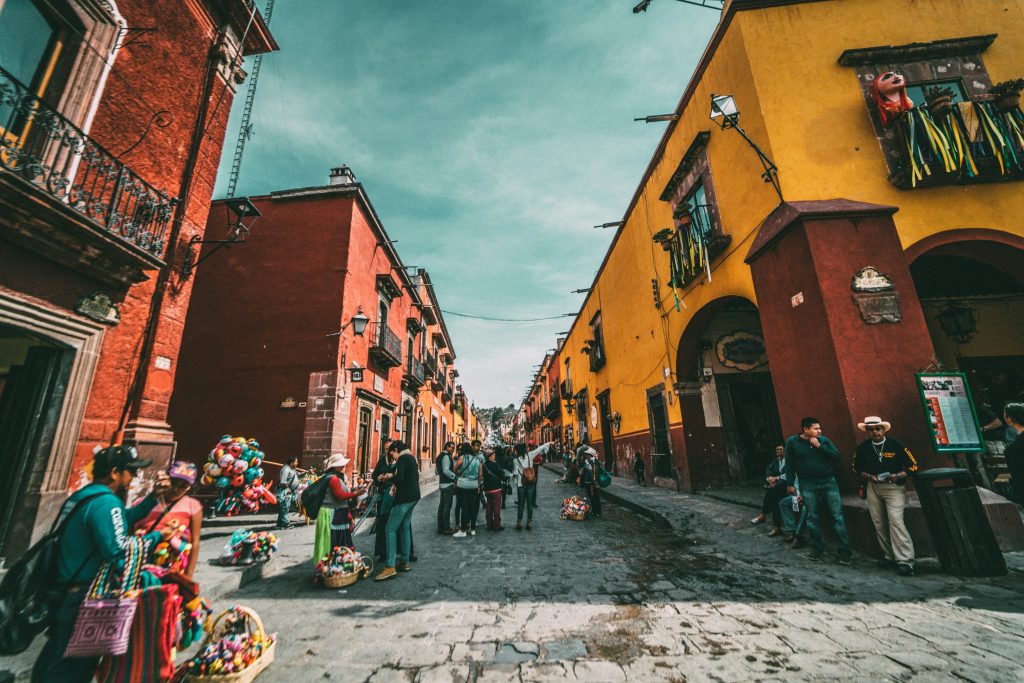
The Representation of the War on Drugs in Mexican Cinema
Author: Andrés Demetrio Gutiérrez Flores
The Drug War in Mexico
The violence stemming from the War on Drugs stands today is the most pressing issue confronting Mexican society. Initiated during the sexennial administration of Felipe Calderón, the period between 2007 and 2019 witnessed approximately 262,007 homicides attributed to the drug trafficking conflict with 93.2% of crimes in 2019 absent from official statistics (Rojo Fierro, 2020).
The films analyzed below fundamentally reproduce the narrative of “they kill each other”, a common justification by former President Felipe Calderón to justify homicides during his government and which continues to be the core of the War on Drugs in the Mexican state. Thus, the dominant themes in the Mexican film industry serve as a propagandistic apparatus for a rhetoric surrounding violence that ignores its systemic causes – that is, the state itself – in favor of a position that is, at least, individualistic, if not outright militaristic and police-oriented.
Within this context, scholarly inquiry into the cinematic representation of violence has gained popularity within the specialized Mexican academic sphere focused on media studies and cinematic critique (Díaz-Cerveró & Domínguez-Partida, 2021). However, what has not been carried out – or at least not presented to the general public – is a text that condenses the relationship between the political discourse that has fueled this barbarism and its representation and legitimation through a hegemonic caste of filmmakers in the art circuit.
The Cinematic Representation of Narcoviolence in Mexican Cinema
Produced in 2013, Heli (Dir. Escalante, 2013), directed by Mexican filmmaker Amat Escalante, stands as one of the emblematic films addressing the violence associated with drug trafficking. While its popularity within Mexico may not rival that of other films within the genre, such as the iconic El infierno (Dir. Estrada, 2010), it marked a milestone internationally, being a finalist for the Palme d’Or and winning the Best Director award at the Cannes Film Festival, shaping the perception of narco-violence in Mexico and influencing similar productions in the subsequent decade.
Nevertheless, as pointed out by Murillo Tenorio (2018, 2019), ethical questions can be raised about Escalante’s portrayal of violence in the film, depicting the mutilation and torture of victims on screen, interpreting a real and atrocious event within the action genre, martyring the victims, and glorifying the perpetrators as strong and powerful characters (Murillo Tenorio & Arellano Rodríguez, 2019).
While the origins of dirty realism in Mexican cinema can be traced back to the early films of Felipe Cazals and Arturo Ripstein, spanning two generations of B-movie filmmakers during the ’80s and ’90s, the truth is that Heli marks a turning point as it crystallizes a specific aesthetic around a particular theme: drug violence. The iconic scene of the film highlights this phenomenon: when the hitmen hang one of the victims by the hands and, in a perfectly polished and choreographed close-up, set their genitals on fire with gasoline.
Following the success of Heli, other films, such as Buy Me a Revolver (Dir. Hernández Cordón, 2018), Chicuarotes (Dir. García Bernal, 2019), I’m No Longer Here (Dir. Frías de la Parra, 2019), Identifying Features (Dir. Valadez, 2020), La civil (Dir. Mihai, 2021), Sundown (Dir. Franco, 2021), Heroic (Dir. Zonana, 2023), Hurricane Season (Dir. Miller, 2023), followed the same path.
One of the most scandalous cases is that of the film La civil, in which a mother, whose daughter has been kidnapped, must take matters into her own hands as she pursues the kidnappers, given the incompetence of the authorities. In a clear thriller and action movie tone, she extrajudicially kills one of the individuals involved and, outside of any legal process, instrumentalizes army personnel to torture women linked to cartels for information. Needless to say, these actions are never questioned but rather portrayed positively as the only way to achieve justice. In this sense, it is a reactionary film that, taking a certain trend in representation to its extremes, only further develops the seed planted in Heli: dehumanization, militarism, disregard for life, insensitivity to victims, and vengeful individualism.
Special mention should be given to the documentaries Tempestad (Dir. Huezo, 2016) and La libertad del diablo (Dir. González, 2017), which, perhaps due to the nature of their genre, manage to partially deviate from the dominant trend and add nuances, both aesthetically and formally, to their representation. They go further to identify and dissect the fundamental causes of violence in Mexico through what Alcalá Anguiano (2021:115) has termed “la poetic del dolor” [the poetics of pain]. Regardless of the accuracy of their conclusions, this attempt deserves acknowledgment, a feature almost entirely absents in fictional productions.
Cinema as a Reflection of Ideological Hegemony in Mexico
In the words of Cebey Montes de Oca (2017): “The past, through images, is connected to the memories that the image produces; with them, there is the possibility of establishing interrelationships and linkages between the past and the present”; it is through memory that the construction of the future, both in its social and institutional dimensions, becomes possible.
However, as insisted, the image is not the simple reflection of the world in which it is created. Its circumstances define it and imbue it with a certain meaning that is already, at its origin, partial and contingent. Then, of course, this meaning is interpreted in a second phase of the heuristic process. This may occur because the image is explicitly produced as propaganda through the State – a phenomenon quite common in both the general history of cinema and the “Golden Age of Mexican Cinema” – or because its creators imprint their concerns and personal conditions on it. These two processes are not, of course, mutually exclusive.
From the above arises the concept of the democratization of cinema’s means of production as a key concept for understanding the relationship between its role as a passive object and as an ideological agent of social reproduction. The political positions and worldviews of a specific group of people will prevail over those of other social groups. Their sensitivity will become the norm and feed itself.
In Mexico, the hegemonic narrative surrounding narco-violence reproduces – despite changes in the government’s ideological orientation – an individualistic perspective rather than a systemic one. It revolves around individual motivation, both on the part of the perpetrators and the victims, as the driving force behind the violence.
Bibliography
Alcalá Anguiano, F. (2021). “Coyunturas éticas y estéticas en el cine documental contemporáneo. Testimonios sobre la guerra contra el narcotráfico en México,” Miguel Hernández Communication Journal 12(1): 105-118
Blanco Pérez, M. 2020. “Estética y contexto de los audiovisuales sobre narcotráfico en Latinoamérica en la era Netflix”, Confluenze 12(1): 102-118
Cebey Montes de Oca, G. (2017). “Cine y ciudad en la modernidad mexicana, 1950-1960” Ph.D. Thesis. Universidad Nacional Autónoma de México.
Díaz-Cerveró and G. Domínguez-Partida. 2021. “El narcotráfico en el cine mexicano: arquetipos desde 2010 a 2017,” Studies in Spanish & Latin American Cinemas 18(2): 211-229
Kusiak, J., and A. Azzouz. (2023). “Comparative urbanism for hope and healing: Urbicide and the dilemmas of reconstruction in post-war Syria and Poland,” Urban Studies, 60(14), 2901-2918.
Rojo Fierro, A. G. 2020. “La guerra contra el narcotráfico en México, ¿un conflicto armado no internacional no reconocido?,” Foro Internacional 4(60): 1415-1462
Mercader, Y. 2012. “Imágenes femeninas en el cine mexicano de narcotráfico,” Tramas (36): 209-237.
Murillo Tenorio, I. M. 2018. “(narco)violence images and imaginaries from fiction in contemporary Mexican cinema,” Imagonautas 12:86-108
Murillo Tenorio, I. M. 2019. “Imaginarios de la narcoviolencia en el cine mexicano contemporáneo” Ph. D. Thesis. Universidad Autónoma de Querétaro.
Murillo Tenorio and J. S. Arellano Rodriguez. 2019. “Apuntes sobre la violencia en el cine mexicano contemporáneo. Una reflexión ético-moral en torno a Heli (Amat Escalante, 2013),” Dilemata (30): 199-216.
Filmography
Chicuarotes. (2019). Directed by: Gael García Bernal. México: Televisa, La corriente de Golfo, Pulse Films, Cinematográfica Amaranto
Cómprame un revolver. (2018). Directed by: Julio Hernández Cordón. México, Colombia: Burning Blue, Woo Films
El infierno. (2010). Directed by: Luis Estrada. México: Instituto Mexicano de Cinematografía, Bandidos Films, Estudios Churubusco Azteca
Heli. (2013). Directed by: Amat Escalante. México, France, Germany, Netherlands: Mantarraya Producciones, FOPROCINE, CONACULTA
Heroico. (2023). Directed by: David Zonana. México, Sweden: Film i Väst, Common Ground Pictures, TEOREMA, Filmadora, CTT Exp & Rentals
La civil. (2021). Directed by: Teodora Ana Mihai. México, Bélgica, Rumania: Les Films du Fleuve, One For The Road Films, Menuetto
Sin señas particulares. (2020). Directed by: Fernanda Valadez. México: Avanti Pictures, Corpulenta Producciones, EnAguas Cine, FOPROCINE, Nephilim Films
Tempestad. (2016). Directed by: Tatiana Huezo. México: Terminal, Pimienta Films, bambú audiovisual, Cactus Film & Video, Estudios Splendor Omnia.
Temporada de huracanes. (2023). Directed by: Elisa Miller. México: Woo Films.
Ya no estoy aquí. (2019). Directed by: Luis Fernando Frías de la Parra. México: PPW Films, Panorama Global
La libertad del diablo. (2017). Directed by: Everardo González. México: Animal de Luz Films, Artegios
Short Bio

Urban planner and film critic. He has provided journalistic coverage of film festivals in Mexico and Europe. His research focuses on the representation of territory and the Critical Urban Theory. Research assistant at the Ruhr-Universität Bochum.
Twitter: @deme_flores
Email: demetriogflores@gmail.com

0 Comments